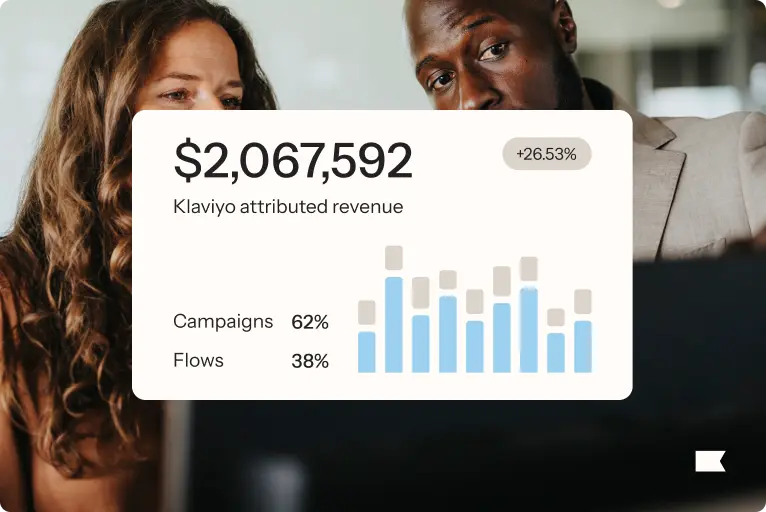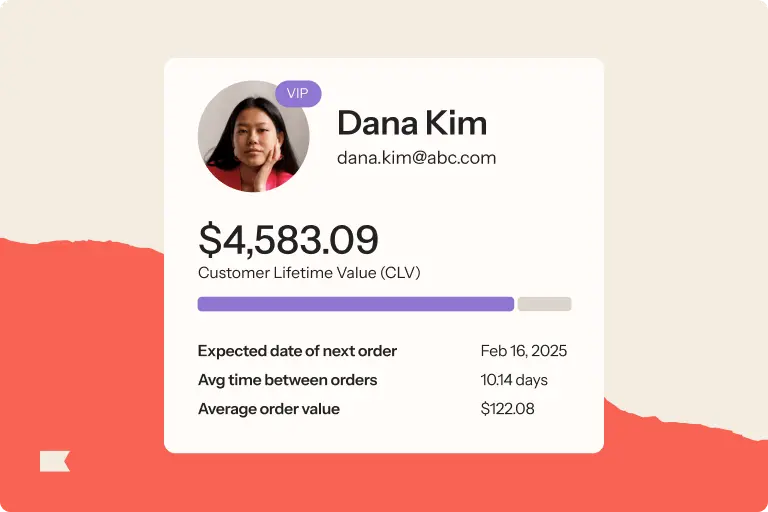What is revenue per recipient (RPR)? Here’s how to calculate and improve it
The success of an email or SMS message goes beyond opens or clicks. You also need to be able to track the message’s impact on revenue.
While engagement metrics are important precursors to success, revenue metrics tell you which messages to replicate and where to allocate your resources. And as part of that revenue metrics package, revenue per recipient (RPR) is one of the most important.
RPR measures how much revenue each message generates. You can view it based on specific emails or SMS messages, or at the automated flow level.
To calculate RPR, you need at least one month’s worth of data, plus two vital pieces of information:
- The total revenue generated from the campaign or automated flow
- The total number of messages sent
Once you’ve gathered these figures, use this RPR formula to get your answer:
RPR = total revenue generated / total number of message sent
Here’s an example. Imagine you�’re running a flash sale and you send an email campaign to a segment of 9,000 subscribers. If you make $1,000 from the sale, your RPR is $0.11 per recipient.
Note: You can use Klaviyo to calculate RPR automatically. RPR may also be called “revenue per email” or “revenue per SMS.” All of these terms refer to the same thing and are calculated the same way.
Why revenue per recipient matters
This marketing metric matters because:
- RPR helps you compare the impact of one campaign to another.
- RPR helps you measure automated flow performance. You can compare message performance within a single flow and even compare the performance of an entire flow to others you have set up.
- RPR is one metric of many that helps you optimize the individual elements that go into making a successful campaign or automated flow. For example, you can use RPR to refine your email send times for flash sales and limited-time promotions.
- By establishing RPR expectations, you can plan each month’s revenue and leverage discounts and other incentives more deliberately. For example, if you offer a 10% coupon code in a campaign, you can calculate the RPR of this email and measure that against how much you spent to offer the discount.
- Tracking RPR over time reveals whether your marketing efforts are improving or if you still have work to do to get the most out of your campaigns and automations.
- Tracking RPR helps you understand which types of messages yield higher returns, which helps focus your time and resources on efforts that are more likely to convert.
- Tracking RPR helps put your marketing spend into context for key stakeholders.
What is a good revenue per recipient?
What constitutes a good RPR varies by brand, industry vertical, and even message channel. Based on the latest Klaviyo benchmarks, the average RPR for an email is $0.11. For SMS, the average RPR is $0.12.
| Category | Average | Top 10% |
| Email campaigns | $0.11 | $0.95 |
| SMS campaigns | $0.12 | $0.77 |
| Automated flows | $1.94 | $16.96 |
| Welcome series | $2.65 | $21.18 |
| Abandoned cart series | $3.65 | $28.89 |
| Browse abandonment series | $1.07 | $7.21 |
| Post-purchase series | $0.41 | $5.14 |
More important than a static result is how your RPR increases or decreases over time. Think of RPR as a comparative reporting metric that can let you know whether you’re on the right track or if you have more work to do on your marketing automation program in general.
6 ways to increase revenue per recipient
Here are 6 of the most effective strategies for increasing your RPR:
1. Clean your lists
Sending campaigns to unengaged subscribers or segments won’t yield much revenue—or at least not as much as you want. These subscribers haven’t opened your messages in a long time or don’t feel connected to your brand, so it’s unlikely they’ll convert now. This reality can impact your RPR (not to mention your deliverability).
Clean your email lists at least once a month by removing hard bounces (even better—use a marketing automation platform to remove them automatically) and creating win-back flows to re-engage subscribers. If that fails, send subscribers off with a sunset flow to make sure your list only contains people who want to hear from you.
2. Segment your audience based on their behavior
Segmenting customers based on demographics is okay, but it’s not enough. In addition, use advanced behavioral segmentation to divide your audience into groups based on:
Every interaction someone has with your brand is a clue about how they might convert via email or SMS message. Segment customers based on the products they browse, the products they put in their carts but don’t buy, and the number of times they visit similar product pages on your website.
Engagement levels are indicators of intent. If someone interacts with a lot of your messages and several of your product pages, it could mean they’re close to making a decision to buy.
You wouldn’t necessarily send the same message to one-time buyers as you would to loyal customers. CLV is a clue about how you should treat your recipients, which can influence RPR.
Mobile accessories brand CaseMate increased their RPR by 22% by creating audience segments based on historical interest in particular brands or device types, such as iPhone or Samsung, then up-selling by pairing those items with matching accessories. They also identified people who opened emails but didn’t make a purchase, and retargeted those recipients with follow-up campaigns or social media ads.
3. Send well-timed, personalized messaging
Segmentation is important because with email and SMS marketing messages, relevance is worth its weight in gold. If your RPR is high, we’re willing to bet your recipients thought your offer was just the right fit for them.
And remember: personalization is about more than just content. You should also make sure your communications are well-timed relative to each other. For example, if you made a splash with a BOGO campaign a month ago, subscribers may be less likely to convert on your 5% flash sale the month after.
Take it from dog gear brand Ruffwear, which used Klaviyo Marketing Analytics RFM segmentation to increase revenue. RFM stands for recency, frequency, and monetary—and it’s how Ruffwear was able to turn disengaged subscribers into repeat buyers. When a customer entered a “Needs attention” or “At risk” RFM segment, it triggered a personalized retention flow that recommended bestsellers the customer hadn’t yet bought.
4. Test different discounts and incentives
Discounts and other incentives should also be relevant to recipients. Send personalized offers to your segments based on behavioral data to drive more sales, and time your offers around high-traffic holidays like BFCM or Christmas.
From time to time, it’s also important to experiment with different discounts and incentives to see how they perform (or underperform). You obviously want to make sure your incentives and discounts help more than harm your business—for example, if a 10% discount creates just a marginal profit, it may not be worth the associated cost.
5. Use bundles to your advantage
Product bundles can be a game-changer for increasing RPR. By strategically grouping products together, you can boost their perceived value and encourage customers to spend more in a single transaction.
You can enhance this strategy with on-the-spot bundle offers. For example, when a customer adds an item to their cart, trigger a pop-up that offers a related bundle at a discount. This approach not only boosts conversion rates but also maximizes the value of the order, which can increase RPR.
Here, see how underwear brand Pair of Thieves puts the power in the hands of their customers by giving them the opportunity to create their own personalized bundle at a discounted rate.

6. Experiment with your CTA copy and placement
Your CTAs are the gateway to a purchase. If you’re seeing low RPR, it could be a sign you need to start experimenting with copy and placement.
Calls to action (CTAs) like “Shop now” or “Learn more” are commonplace, but they’re not the most eye-catching. CTA placement can also affect your conversion rates. And while positioning CTAs above the fold is a general best practice, you should always test different placements to see what yields the most clicks.
In this email, wellness brand Golde uses 3 CTA options—“don’t wait,” “20% off Superwhisk,” and “shop Superwhisk”—in 3 different places to encourage subscribers to buy in several different ways.

Use revenue per recipient to inform your sending strategy
Now that you have a firm understanding of RPR, you can use it alongside your engaged list to plan your month’s marketing strategy.
Based on your RPR rate, make changes that reflect what seems to work for you. If your RPR is lower than expected, consider the following:
- How often are you currently messaging subscribers?
- What specific characteristics, styles, and blocks are working best in your emails and SMS messages?
- How engaged are the audiences receiving your emails?
- Are incentives (e.g., discounts) working in your emails or not?
- Are subscribers even receiving your emails?
You can likewise find your expected email revenue by multiplying your email list size by your number of campaigns, then multiplying that number by your RPR.
Improve your revenue per recipient with personalization
Personalization is at the heart of conversion, and creating advanced audience segments improves your personalization strategies and boosts your RPR.
Brands like Budgy Smuggler use Klaviyo to tap into niche Australian subcultures to increase revenue with content relevance.
“Previously, when we’d release prints, we’d be blasting the whole list,” explains Adam Linforth, founder and CEO of Budgy Smuggler. “Now, it can be really hyper-targeted.”


Related content

Achieve more in 3 months with Klaviyo Marketing Analytics. This calendar gives you the structure and documentation you need to level up.

Discover 6 data-driven ways to use Klaviyo Marketing Analytics to boost BFCM performance, personalize campaigns, and drive long-term customer retention.

Use this quick customer lifetime value formula to understand your business health and customer experience.